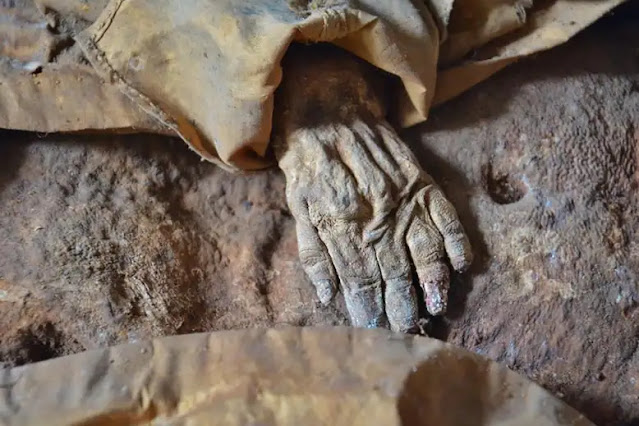A young child discovered in an unmarked coffin in an Austrian crypt was exceptionally well preserved, with signs of rickets and pneumonia in his bones and organs.
 |
| A closer look at the mummified child's hand. A. G. Nerlich and colleagues/Frontiers |
According to researchers who conducted a "virtual autopsy" on the mummified body of an infant born into an aristocratic Austrian family in the 17th century, the infant died overweight but may have been vitamin D deficient.
Scans of the remarkably well-preserved body revealed knobbly extensions on the rib joints typical of rickets, which is caused by a lack of vitamin D, as well as thick layers of fat - which likely aided in tissue mummification. According to Andreas Nerlich of the Academic Clinic Munich-Bogenhausen in Germany, the findings suggest the child was overfed and underexposed to sunlight, which led to his death.
After an unmarked wooden coffin was discovered in a crypt near a castle in Upper Austria, Nerlich and his colleagues examined the infant's remains. The crypt had consistent airflow and a stable temperature, which likely helped the child's body dry out. "This is one of the very few cases where an aristocratic infant spontaneously mummified - and was available for scientific investigation," he says.
The researchers estimated that the child was buried around 400 years ago based on radiocarbon dating of the body and records of the crypt's construction. Given the infant's approximate age at death - between 10 and 18 months old - and silk wraps indicative of aristocratic birth, they believe the child was Reichard Wilhelm, the first-born son of the Count of Starhemberg, who lived from 1625 to 1626.
The researchers confirmed the child's gender using computed tomography (CT) scans of the body, and his bone measurements and tooth eruption were consistent with a child of about a year old.
 |
| The baby mummy discovered in the crypt A. G. Nerlich and colleagues/Frontiers |
Scans of his rib bones revealed rachitic rosary, a condition common in severe rickets cases. Rickets is caused by a deficiency in vitamin D, which the body produces when exposed to ultraviolet sun rays. While his leg bones were not bowed, which is a tell-tale sign of rickets in older children, Nehrlich believes this was due to the infant's inability to walk. However, one arm bone appeared to be slightly bent.
He says the infant's lungs were inflamed, implying he died of pneumonia, a disease that is more common in children with rickets.
"The combination of obesity and severe vitamin deficiency can only be explained by a generally 'good' nutritional status combined with an almost total lack of sunlight exposure," Nerlich says.
It is unclear whether this combination of characteristics was common, but early infant mortality rates were generally high in the upper social classes during the Renaissance, according to Nerlich.
Journal citation: Frontiers in Medicine DOI: 10.3389/fmed.2022.979670
